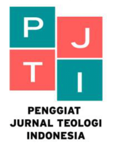Faktor-Faktor Pembentukan Karakter berdasarkan Amsal 13:22 tentang Warisan Harta dan Ajaran Moral
Abstract
This article describes “the factors of character building based on Proverbs 13:22 on inheritance and moral teachings.” The uniqueness of the book of Proverbs is that besides discussing the importance of the relationship between God and humans, it also shows the importance of Character Building. The analysis of this scientific work uses the research method of Wisdom Hermeneutics, which uses literal, context, structural and figurative analysis. The nature of a righteous person deserves to bequeath property to children / other people to obtain inheritance rights. Robert Williamson provides an interpretation of Proverbs 13:22 by emphasizing the habit of experience as the main factor in character building, while Mark Rathbone finds that the family/community factor is a habit /culture in the interpretation of Proverbs 13:22. But from the other side, this article shows that the Interpretation of Proverbs 13:22 discover 4 factors for character building regarding inheritance and moral teachings, namely: Personality Factors, Life Example, Communication and Financial Literacy. Where these factors are passed from one generation to another.
Downloads
References
Berkowitz, Marvin W., and Melinda C. Bier. “Research Based Character Education.” Annals of the American Academy of Political and Social Science, 2004. https://doi.org/10.1177/0002716203260082.
Bland, Dave. “Formation of Character in the Book of Proverbs.” Restoration Quarterly 40, no. 4 (1998): 226–27.
Boyatzis, Chris J., and Denise L. Janicki. “Parent-Child Communication about Religion: Survey and Diary Data on Unilateral Transmission and Bi-Directional Reciprocity Styles.” Review of Religious Research, 2003. https://doi.org/10.2307/3512386.
Branick, Vincent P. “Wisdom, Pessimism, and ‘Mirth’: Reflections on the Contribution of Biblical Wisdom Literature to Business Ethics.” Journal of Religious Ethics, 2006. https://doi.org/10.1111/j.1467-9795.2006.00256.x.
Clifford, Richard J. “Reading Proverbs 10–22.” Interpretation: A Journal of Bible and Theology 63, no. 3 (2009): 248. https://doi.org/10.1177/002096430906300303.
———. “Reading Proverbs 10–22.” Interpretation: A Journal of Bible and Theology 63, no. 3 (2009): 248. https://doi.org/10.1177/002096430906300303.
Crenshaw, James L. “Book Review: Character in Crisis: A Fresh Approach to the Wisdom Literature of the Old Testament.” Interpretation: A Journal of Bible and Theology 51, no. 4 (October 8, 1997): 423. https://doi.org/10.1177/002096439605100410.
Domeris W.R. Old Testament Essays. SOUTH AFRICA: Old Testament Society of South Africa (OTSSA), 1995.
Fox, Michael V. “The Rhetoric of Disjointed Proverbs.” Journal for the Study of the Old Testament 29, no. 2 (2004): 165–77. https://doi.org/10.1177/030908920402900204.
Gold, Neal. “‘ Guzzlers and Gluttons Will Be Impoverished ’: The Rhetoric of Wealth , Poverty , and Their Causes in the Book of Proverbs.” The Reform Jewish Quaterly 3, no. 4 (2020): 180.
Heim, Knut M. “Prov 26 : 1-12 : A Crash Course on the Hermeneutics of Proverb Reception and a Case Study in Proverb Performance Response Author ( s ): Knut Heim Source : Die Welt Des Orients , Bd . 40 , H . 1 ( 2010 ), Pp . 34-53 Published by : Vandenhoeck & Ruprecht (.” Die Welt Des Oriensts 1, no. 2010 (2010): 34–53.
Hertzler, J. O. “The Social Wisdom of the Primitives with Special Reference to Their Proverbs.” Social Forces, 1933. https://doi.org/10.2307/2569643.
Hildebrandt, Ted. “Motivation and Antithetic Parallelism in Proverbs 10-15.” Journal of the Evangelical Theological Society 35, no. 4 (1992): 433–44.
———. “Proverbial Pairs: Compositional Units in Proverbs 10-29.” Journal of Biblical Literature 107, no. 2 (1988): 207. https://doi.org/10.2307/3267696.
Huitt, William. “Moral and Character Development.” Educational Psychology Interactive, 2004, 1–10.
Ivcevic, Zorana, Marc A. Brackett, and John D. Mayer. “Emotional Intelligence and Emotional Creativity.” Journal of Personality, 2007. https://doi.org/10.1111/j.1467-6494.2007.00437.x.
Jacobs, Janis E., Christina S. Chhin, and Katherine Shaver. “Longitudinal Links between Perceptions of Adolescence and the Social Beliefs of Adolescents: Are Parents’ Stereotypes Related to Beliefs Held about and by Their Children?” Journal of Youth and Adolescence, 2005. https://doi.org/10.1007/s10964-005-3206-x.
Kichiro Yuasa. “A Classification of the Solomonic Proverbs.” The Old and New Testament Student 13, no. 3 (2014): 148.
Koerner, Ascan F. “Family Communication.” In Interpersonal Communication, 2014. https://doi.org/10.1515/9783110276794.419.
McFerran, Brent, Karl Aquino, and Michelle Duffy. “How Personality and Moral Identity Relate to Individuals’ Ethical Ideology.” Business Ethics Quarterly, 2010. https://doi.org/10.5840/beq20102014.
Mude, Emilia. “Cyber Parenting In Society 5 . 0.” Integritas:Jurnal Teologi 2, no. 1 (2020): 69.
Newsom, Carol A. “Models of the Moral Self: Hebrew Bible and Second Temple Judaism.” Journal of Biblical Literature, 2012. https://doi.org/10.2307/23488209.
Pemberton, Glenn D. “It’s a Fool’s Life: The Deformation of Character in Proverbs.” Restoration Quarterly 50, no. 4 (2008): 223–24.
Rathbone, Mark. “Self-Interest, Wealth and the Book of Proverbs in the South African Context: Towards a Smithian Alternative.” HTS Teologiese Studies / Theological Studies 75, no. 3 (2019): 1–10. https://doi.org/10.4102/hts.v75i3.5123.
Schwáb, Zoltán. “The Sayings Clusters in Proverbs: Towards an Associative Reading Strategy.” Journal for the Study of the Old Testament 38, no. 1 (2013): 59–79. https://doi.org/10.1177/0309089213492817.
Stiebert, Johanna. “The Inculcation of Social Behaviour in Proverbs.” Old Testament Essays 2, no. 17 (2004): 282–93.
Sualang, Farel Yosua. “Prinsip-Prinsip Hermeneutika Genre Hikmat Dalam Kitab Amsal: Suatu Pedoman Eksegesis.” Jurnal PISTIS 1, no. Old Testament, Genre of Wisdom, Hermeneutics (2019): 93–112. https://doi.org/10.31227/osf.io/xmk6h.
VanKatwyk, P. L. “Towards a Balanced Whole: The Well-Functioning Family.” Journal of Pastoral Care, 2001. https://doi.org/10.1177/002234090105500302.
WALTKE, Bruce. “RIGHTEOUSNESS IN PROVERBS.” The Westminster Theological Journal, 2008.
Walton, Douglas. Character Evidence, An Abductive Theory. Profiles of Drug Substances, Excipients, and Related Methodology, 2011.
Williamson, Robert. “‘In the Way of Righteousness Is Life’: Symbolic Death Transcendence in Proverbs 10-29.” Journal for the Study of the Old Testament 38, no. 3 (2014): 376. https://doi.org/10.1177/0309089214527210.
Wright, Benjamin G. “Praise Israel for Wisdom and Instruction: Essays on Ben Sira and Wisdom, the Letter of Aristeas and the Septuagint.” Supplements to the Journal for the Study of Judaism, 2008.
Zaluchu, Sonny Eli. “Pola Hermenetik Sastra Hikmat Orang Ibrani.” Evangelikal: Jurnal Teologi Injili Dan Pembinaan Warga Jemaat 3, no. 1 (2019): 21. https://doi.org/10.46445/ejti.v3i1.123.
Copyright (c) 2020 Integritas: Jurnal Teologi

This work is licensed under a Creative Commons Attribution 4.0 International License.
This work is licensed under a Creative Commons Attribution-ShareAlike 4.0 International License.
Copyright © Integritas: Jurnal Teologi 2020. All Rights Reserved.









.png)




